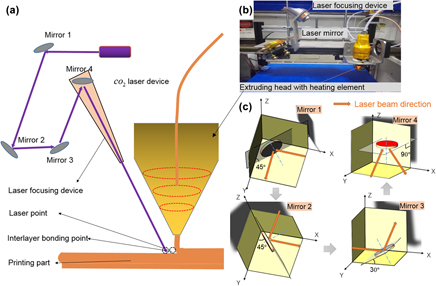Crossref Citations
This article has been cited by the following publications. This list is generated based on data provided by
Crossref.
Zhu, Weijun
Zhang, Xiaoyu
and
Li, Dichen
2019.
Flexible all-plastic aircraft models built by additive manufacturing for transonic wind tunnel tests.
Aerospace Science and Technology,
Vol. 84,
Issue. ,
p.
237.
Vaes, Dries
Coppens, Margot
Goderis, Bart
Zoetelief, Wim
and
Van Puyvelde, Peter
2019.
Assessment of Crystallinity Development during Fused Filament Fabrication through Fast Scanning Chip Calorimetry.
Applied Sciences,
Vol. 9,
Issue. 13,
p.
2676.
Zhu, Weijun
Miao, Kai
and
Li, Dichen
2019.
Static aeroelastic models with integrated stiffness-contributing shell structures built by additive manufacturing.
Engineering Structures,
Vol. 187,
Issue. ,
p.
352.
Li, Qiushi
Zhao, Wei
Li, Yongxiang
Yang, Weiwei
and
Wang, Gong
2019.
Flexural Properties and Fracture Behavior of CF/PEEK in Orthogonal Building Orientation by FDM: Microstructure and Mechanism.
Polymers,
Vol. 11,
Issue. 4,
p.
656.
Luo, Meng
Tian, Xiaoyong
Shang, Junfan
Yun, Jingxin
Zhu, Weijun
Li, Dichen
and
Qin, Yingjie
2020.
Bi-scale interfacial bond behaviors of CCF/PEEK composites by plasma-laser cooperatively assisted 3D printing process.
Composites Part A: Applied Science and Manufacturing,
Vol. 131,
Issue. ,
p.
105812.
Wu, Yin
Cao, Yi
Wu, Ying
and
Li, Dichen
2020.
Neutron Shielding Performance of 3D-Printed Boron Carbide PEEK Composites.
Materials,
Vol. 13,
Issue. 10,
p.
2314.
Shang, Junfan
Tian, Xiaoyong
Luo, Meng
Zhu, Weijun
Li, Dichen
Qin, Yingjie
and
Shan, Zhongde
2020.
Controllable inter-line bonding performance and fracture patterns of continuous fiber reinforced composites by sinusoidal-path 3D printing.
Composites Science and Technology,
Vol. 192,
Issue. ,
p.
108096.
Wang, Xin
Tian, Xiaoyong
Yin, Lixian
and
Li, Dichen
2020.
3D Printing of Continuous Fiber Reinforced Low Melting Point Alloy Matrix Composites: Mechanical Properties and Microstructures.
Materials,
Vol. 13,
Issue. 16,
p.
3463.
Wang, Xin
Tian, Xiaoyong
Lian, Qin
and
Li, Dichen
2020.
Fiber Traction Printing: A 3D Printing Method of Continuous Fiber Reinforced Metal Matrix Composite.
Chinese Journal of Mechanical Engineering,
Vol. 33,
Issue. 1,
Pandelidi, Chrysoula
Bateman, Stuart
Piegert, Sebastian
Hoehner, Rene
Kelbassa, Ingomar
and
Brandt, Milan
2021.
The technology of continuous fibre-reinforced polymers: a review on extrusion additive manufacturing methods.
The International Journal of Advanced Manufacturing Technology,
Vol. 113,
Issue. 11-12,
p.
3057.
Guo, Cheng
Liu, Xiaohua
and
Liu, Guang
2021.
Surface Finishing of FDM-Fabricated Amorphous Polyetheretherketone and Its Carbon-Fiber-Reinforced Composite by Dry Milling.
Polymers,
Vol. 13,
Issue. 13,
p.
2175.
Syrlybayev, Daniyar
Zharylkassyn, Beibit
Seisekulova, Aidana
Akhmetov, Mustakhim
Perveen, Asma
and
Talamona, Didier
2021.
Optimisation of Strength Properties of FDM Printed Parts—A Critical Review.
Polymers,
Vol. 13,
Issue. 10,
p.
1587.
Bengfort, Philipp
Stracke, Dennis
and
Künne, Bernd
2021.
Establishment of a Rotary Print Head to Effect Residual Stresses and Interlayer Bonding in an FLM-Process.
Journal of Manufacturing and Materials Processing,
Vol. 5,
Issue. 3,
p.
82.
Liaw, Chya-Yan
Tolbert, John W.
Chow, Lesley W.
and
Guvendiren, Murat
2021.
Interlayer bonding strength of 3D printed PEEK specimens.
Soft Matter,
Vol. 17,
Issue. 18,
p.
4775.
Li, Qiushi
Zhao, Wei
Niu, Bingjie
Wang, Yiliang
Wu, Xinhui
Ji, Jiawen
Li, Yongxiang
Zhao, Tingting
Li, Han
and
Wang, Gong
2021.
3D printing high interfacial bonding polyether ether ketone components via pyrolysis reactions.
Materials & Design,
Vol. 198,
Issue. ,
p.
109333.
Vaes, Dries
and
Van Puyvelde, Peter
2021.
Semi-crystalline feedstock for filament-based 3D printing of polymers.
Progress in Polymer Science,
Vol. 118,
Issue. ,
p.
101411.
Zhang, Yongjie
and
Moon, Seung Ki
2021.
The Effect of Annealing on Additive Manufactured ULTEM™ 9085 Mechanical Properties.
Materials,
Vol. 14,
Issue. 11,
p.
2907.
Xu, Qinfei
Shang, Yingshuang
Jiang, Zilong
Wang, Zhaoyang
Zhou, Chenyi
Liu, Xin
Yan, Qixing
Li, Xuefeng
and
Zhang, Haibo
2021.
Effect of molecular weight on mechanical properties and microstructure of 3D printed poly(ether ether ketone).
Polymer International,
Vol. 70,
Issue. 8,
p.
1065.
Shang, Yingshuang
Xu, Qinfei
Jiang, Bo
Yang, Yang
Liu, Xin
Jiang, Zilong
Yu, Chang
Li, Xuefeng
and
Zhang, Haibo
2022.
Slowing crystallization to enhance interlayer strength of 3D printed poly (ether ether ketone) parts by molecular design.
Additive Manufacturing,
Vol. 59,
Issue. ,
p.
103104.
Jiang, Houfeng
Aihemaiti, Patiguli
Aiyiti, Wurikaixi
and
Kasimu, Ayiguli
2022.
Study Of the compression behaviours of 3D-printed PEEK/CFR-PEEK sandwich composite structures.
Virtual and Physical Prototyping,
Vol. 17,
Issue. 2,
p.
138.



